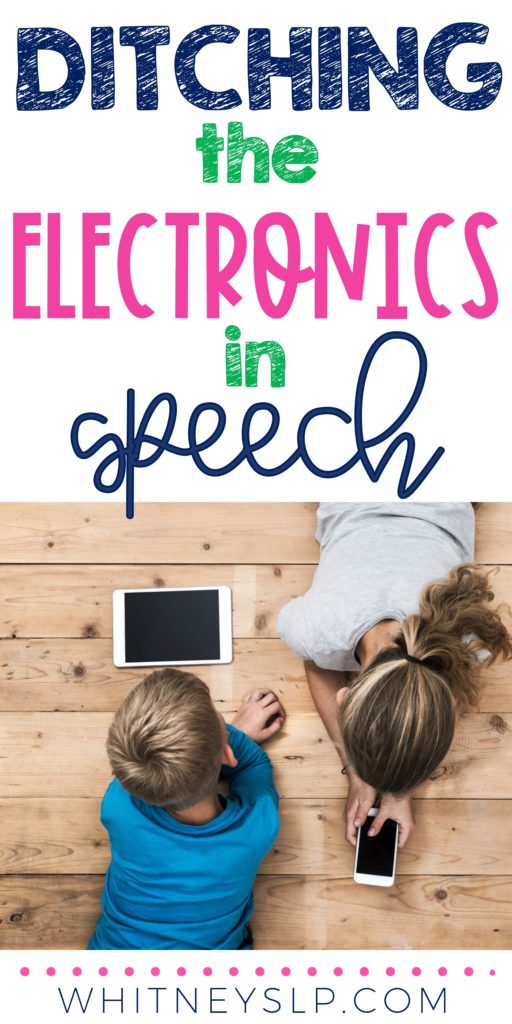By now, I’m sure you’re no stranger to the screen time debate in regards to young children. Recent studies have linked increased screen time to decreased speech and language skills, increased hyperactivity, and even Autism, to name a few. But like sweets, is screen time something that can be acceptable in moderation? Read on to learn why I began ditching the electronics in speech therapy.

As a Speech Language Pathologist in an elementary school and mother to two (5 years and 18 months), the conflict over too much screen time is frequently on my mind. It is no secret that screen time has increased astronomically over the past decade, as technological advances place electronics at our fingertips everywhere we go.
AAP Guidelines:
Recently, the American Academy of Pediatrics updated their guidelines for electronic use in young children. The AAP recommends no screen time for children under 18 months except video chatting. For children 18-24 months, they recommend very limited time with the parent watching it with their children. For children 2-5 years, the AAP suggests no more than 1 hour a day of a high-quality program. And for children 6 years and older, the AAP recommends setting clear and consistent limits on the time and type of screen time, while maintaining media-free times and places, such as in the bedroom.
The Statistics:
Despite the warnings, screen time continues to increase. Gone are the days of pay phones, dial-up internet at the public library, or even the occasional video game played among families. Nearly everyone has a cell phone these days, or at a minimum, easy access to one. In fact, a recent study in Britain found that 25% of children under 6 years old have a smartphone. Even worse, 8-10 of the parents surveyed indicated that they do not keep tabs on the amount of time their children are on the phone. An additional statistic showed that over 40% of children have a television in their bedroom by the age of 6, and teens spend 8-9 hours a day on their smartphones.
Does increased screen time affect language development?
An additional study was conducted by Catherine Birken, a pediatrician and scientist at the Hospital for Sick Children in Toronto. This study, conducted from 2011-2015, included 900 toddlers ages 6-24 months. Birken asked the parents to estimate how often their children had hand-held screens. At the same time, Birken and her colleagues completed the Infant Toddler Checklist, a screening tool for signs of delayed communication development.
Birken found that by their 18 month checkup, 20% of the children used electronic devices 28 minutes on average each day. When compared with the results from the Infant Toddler Checklist, the higher the amount of time on hand-held devices, the higher the likelihood the child exhibited delays in expressive speech. Even more telling, Birken and her colleagues found that each additional 30 minutes of screen time was linked to a 49% increased risk in an expressive language delay.
But I just need a few minutes of PEACE!!!
Ok, let’s be honest. Electronics can be tempting. As an SLP, I talk all day. By the time I get home in the afternoon, I’m exhausted. I still need to cook dinner, do a load of laundry, help my daughter with homework, pack lunches and get clothes ready for the next day, do bath time, clean up dinner, and more. Sometimes the 18 month old is fussy and makes doing all of those things challenging when he just wants to be held.
Passing him the iPad or turning on Peppa Pig would give me a few minutes of peace to do all the things I need to do. The same goes when I’m driving and just need a few minutes without the kids fighting in the back seat. Or when I’d just like to have a quiet dinner in a restaurant without getting glares from other diners about my impatient children. Or when I’m flying through the grocery store to pick up a few necessities with kids who don’t want to be there any more than I do. And, and, and…..Do you see where I’m going here? If we get into the habit of using the electronics as babysitters, the amount of screen time really starts to add up!
While I won’t say I never let my own children watch an episode of Peppa Pig or watch nursery rhymes on the iPad, my husband and I have established solid guidelines for our children’s screen time.
But then there is school….
Several years ago, I accidentally forgot to charge my iPad before speech therapy. The iPad died, and I couldn’t use it that day in speech. I actually wrote a post about that day that you can read HERE. After that experience, I had to take a long hard look at my speech therapy lessons.
I realized that I had gotten into the habit of using the iPad every day for almost all of my students. At the time, I was working in an outpatient pediatric rehab setting where materials were scarce, but shortly after that, I moved back into the schools where I am today. In my new school, over 75% of my caseload was students on the Autism Spectrum or students with more severe developmental delays. Many of my students were nonverbal.
It didn’t take me long to realize that using the iPad or other technology with those students was simply not functional. Most of these children were drawn to the technology and would using it for stimming. I also had quite a few students who could receptively identify items, follow directions, and identify shapes, colors, or letters using the iPad, but could not do this “in real life” without technology involved. I soon realized that continuing to use the iPad with these students in speech therapy would do them a huge disservice.
Technology expectations in school:
In this day and time, technology is not only encouraged in the classroom, but in some ways, it’s even mandated. Teachers are actually evaluated on how often they incorporate technology into their lessons. When I realized this and took a quick mental count of how often my students (general education students too) were exposed to screen time throughout the school day alone, I knew I couldn’t in good conscious expose them to more screen time in the speech room.
Now is a good time for me to make two important notes:
- There are many amazing iPad apps out there for speech therapy. I have not only used them myself, but I’ve written tons of reviews of them that you can find by doing a quick search on the blog. I am in no way advocating for you to never use iPad apps in your speech therapy. Apps still find their way into my therapy sessions on occasion, and I still think they are awesome. But it’s all about knowing your students (individualized instruction, right?). And moderation.
- “Screen time” does not count for AAC devices used for communication. If your student has an AAC device to communicate, that is their voice. They can’t communicate without it. So never take it away from them. Ever. (Although, if they are using it to play games all day instead of communicating, we should probably address that.)
Ok, So About Moderation…
While I have stopped using the iPad and other electronic devices every day in speech therapy (and altogether with many of my students), I do still incorporate technology in very specific and limited ways. Here are my tips if you do choose to incorporate electronics in moderation. (These are also tips I give my parents for home use!)
When you’re using technology, practice co-viewing.
Sit with your students or children while they are using the device. Pause from time to time and ask questions or comment. Encourage active screen time as opposed to passive screen time when they can just get lost in a mindless trance.
Consider Facetime or Skype. (With permission if you’re in a school).
Children learn a lot by back and forth communication with others, especially with other adults in their life. In a private setting, you might have a patient with a grandparent that lives far away. I have asked the parents before if we can Facetime grandparents in another state during therapy to work on conversational skills, eye contact, and more. This is highly motivating for patients AND those grandparents who are thrilled to be included and helping in therapy while visiting with their loved ones.
Use pictures of the children saved on the parents phone as topics of discussion in therapy.
This works great for all ages! Children love talking about what they did over the weekend, and this is also great for improving memory! Have they recently been on vacation? Gotten a new pet? Ask parents to send you pictures to incorporate into speech!
Consider using Youtube for real-life videos to support your lessons.
If we are studying about the farm, I will sometimes pull up videos of real farm animals, and we’ll listen to their sounds, comment about what they are doing, etc. Real-life pictures and video help students make connections, increase vocabulary, and increase communication skills.
As mentioned before, continue to use AAC devices as your students’ means of communication.
Never keep them from their voice. Although if a student is used to using the device to play games instead of communicate, I sometimes have to discuss removing the gaming options with parents until there is more balance.
Set time limits. And keep them.
This may be 5 minutes at the end of the speech therapy session after a student has completed their work. Or it may be only between certain times of the day at home. Either way, set time limits, and stick to them.
Don’t use the iPad as a placater.
I pretty much refuse to give my students the iPad just so they will calm down or stop doing something. I also try to be very intentional of this at home. If a student screams the entire therapy session unless you bring out the iPad, that’s a red flag. If your child will not eat dinner unless he is watching his favorite show, that’s also a red flag. I know this one is so hard!! If you are going to give them electronic time, wait until they are calm before giving it to them. This way, they won’t associate pitching a fit with being handed what they want.
Real life mixed with moderation:
I once handed a student a book to look at, and she tried to swipe the page in the book so the page would turn. Her mom told me they read books to her on the iPad, but they had never given her a real book. Reading with your students or children using the iPad or Kindle is fine….in moderation. But don’t forget to mix in the real life or tangible items too!
Additional Links:
- https://www.joshuastraub.com/2018/06/04/3-disturbing-screen-time-statistics-parents-know/
- https://www.speechandlanguagekids.com/screen-time-and-language-development/
- https://blog.asha.org/2018/02/26/help-families-find-a-screen-time-balance/
- https://blog.asha.org/2018/11/30/balancing-screen-time-use-with-young-
- clients-and-their-parents/
- http://www.center4research.org/young-children-screen-time-tv-computers-etc/
How do you feel about ditching the electronics in speech therapy? Do you use them in moderation, quite a lot, or not at all? I’d love to hear your thoughts in the comments below!!!












Hey! I especially liked your comments about “active screen time,” “mindless trance,” and maintaining limits.